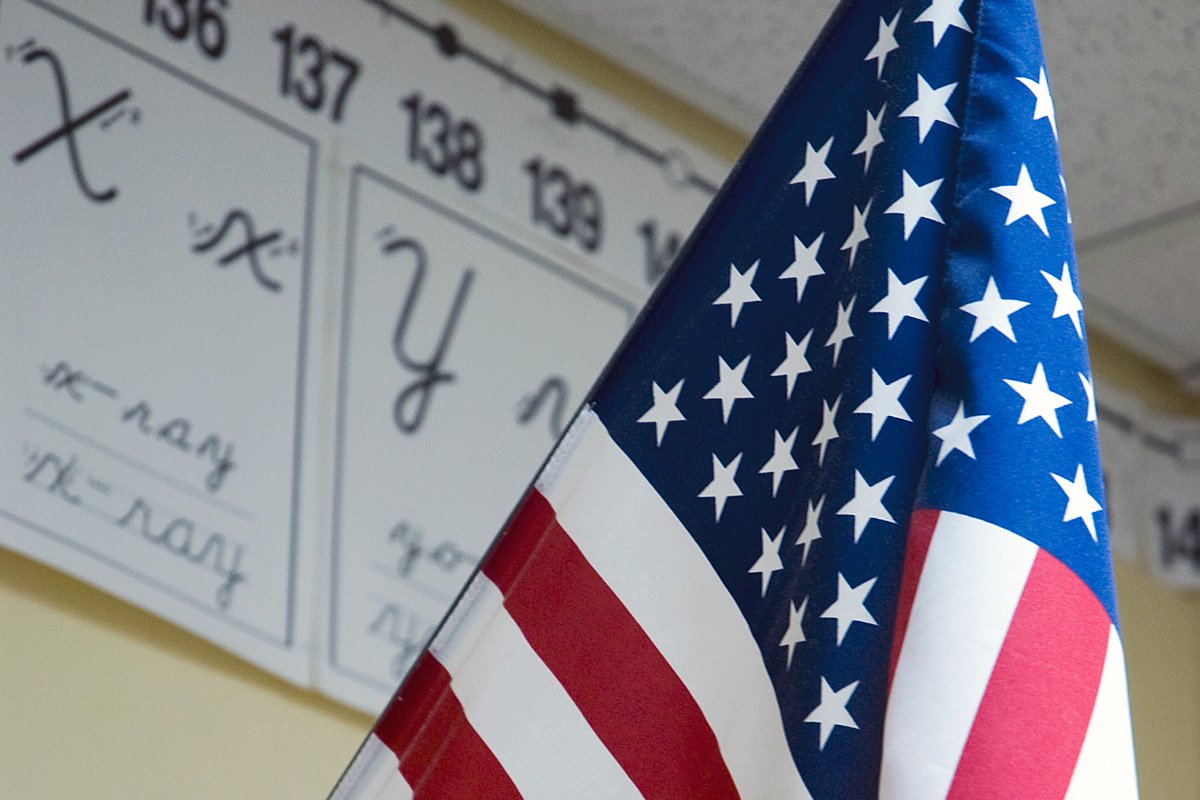
Civil Religion as a Gateway to Christian Nationalism
The inclusion of “under God” in the U.S. Pledge of Allegiance was a sectarian move whose exclusionary effects are increasingly evident in today's religious landscape.
Seventy years ago, the Pledge of Allegiance to the American flag was baptized. For its first six decades, the Pledge was “godless,” going straight from “one nation” to “indivisible.” President Dwight D. Eisenhower changed that on Flag Day, June 14, in 1954, as he signed congressional legislation to add “under God” to the national oath. While politicians officially rewrote the Pledge, this change occurred because of a preacher’s sermon.
As Rev. George Docherty of New York Avenue Presbyterian Church in Washington, D.C., prepared his message for Sunday morning worship on February 7, 1954, he knew Eisenhower would be sitting in the pew. Specifically, Ike would be sitting in the Lincoln family pew. Since the sixteenth president had worshiped there, the church had developed a tradition of getting presidents to show up for “Lincoln Sunday” in early February near Lincoln’s birthday. So Docherty prepared his sermon for an audience of one with a singular mission: Get “under God” added to the Pledge.
During his sermon, Docherty defined “the American way of life” as based on the Ten Commandments and “the words of Jesus of Nazareth, the living Word of God for the world.” The absence of “God” from the Pledge, for him, represented a serious problem because the U.S. faced “a theological war” against Soviet communism.
“It is Armageddon, a battle of the gods,” he added. “To omit the words ‘under God’ in the Pledge of Allegiance is to omit the definitive character of the American way of life.”
The sermon worked. Members of Congress requested copies the next day. It was reprinted in the Congressional Record and clips of it ran in newsreel segments in theaters. The legislation to add “under God” moved quickly, climaxing with Eisenhower signing it just four months later on Flag Day. Members of Congress celebrated on June 14th by assembling on the steps of the U.S. Capitol to say the new version and sing “Onward, Christian Soldiers.”
What’s particularly telling from Docherty’s sermon is his treatment of those who might theologically disagree with the inclusion of God in the Pledge. He specifically defined atheists as not real Americans, drawing them outside the boundaries of national belonging. He articulated this narrow understanding of citizenship while standing in the pulpit of a prominent Presbyterian church with the U.S. president in attendance (Docherty’s predecessor had been the influential Peter Marshall, a chaplain of the U.S. Senate and the subject of the book and film A Man Called Peter). From this privileged place, he had a message to share about what he thought should be the relationship between religious and national identity.
“Philosophically speaking, an atheistic American is a contradiction in terms,” he argued. “They really are spiritual parasites. … If he denies the Christian ethic, he falls short of the American ideal of life.”
The “under God” crusade came with the explicit admission that in rewriting the Pledge, the nation’s leaders would be civically excommunicating some citizens as not real, patriotic Americans. To proclaim one’s loyalty to America required making a religious confession as well. It was a shift made during the Cold War to make a stark contrast between the U.S. and its communist enemies.
This fusion of American and Christian identity mirrors the Christian Nationalism frequently on display and denouncedin public life today. The difference between now and then is that those leading the cause were not conservative evangelicals but mainline Protestants.
The admission of the exclusionary nature of adding “under God” into the Pledge should lead scholars today to reconsider Robert Bellah’s concept of “civil religion.” After all, he specifically cited “the inclusion of the phrase ‘under God’ in the Pledge to the flag” as an example of this concept. For Bellah, the nation needed common symbols and rituals that provided “an understanding of the American experience in the light of ultimate and universal reality.” While Bellah argued such unifying beliefs and symbols contrasted with religious nationalism, Docherty’s sermon reveals the true motives of the effort. From the beginning, the inclusion of “under God” was a sectarian move intended to cast out some Americans instead of uniting the populace.
The punch of “under God” hits even worse today. When Bellah published his first essay on civil religion in 1967, ninety-two percent of Americans identified as Christian, with three percent Jewish, three percent of another faith, and only two percent claiming no faith. Although still exclusionary, Docherty sought to define only a small part of the population as inherently un-American. Today, however, demographic changes demonstrate how civil religion increasingly functions like Christian nationalism. Now, only sixty-six percent of Americans identify as Christians, with two percent Jewish, eight percent of another faith, and twenty-one percent claiming no religion. Docherty’s sermon—and Eisenhower’s signature—target a significant portion of the U.S.
With such religious diversity, a covenant or civil religion borrowing from Christian symbols and language not only will resonate with fewer people, but is incapable of unifying a religiously pluralistic nation. If a civil religious alternative to religious nationalism could ever flourish in a healthy way for a body politic, that era is in the past for the United States. The covenant Bellah described has expired. Attempts at civil religion today might not function much differently from Christian Nationalism as both define a growing swatch of U.S. citizens as not fundamentally part of what Bellah saw as “the American Way of Life.”
Featured image by JS Dust. Used with CC BY 2.0 license.


